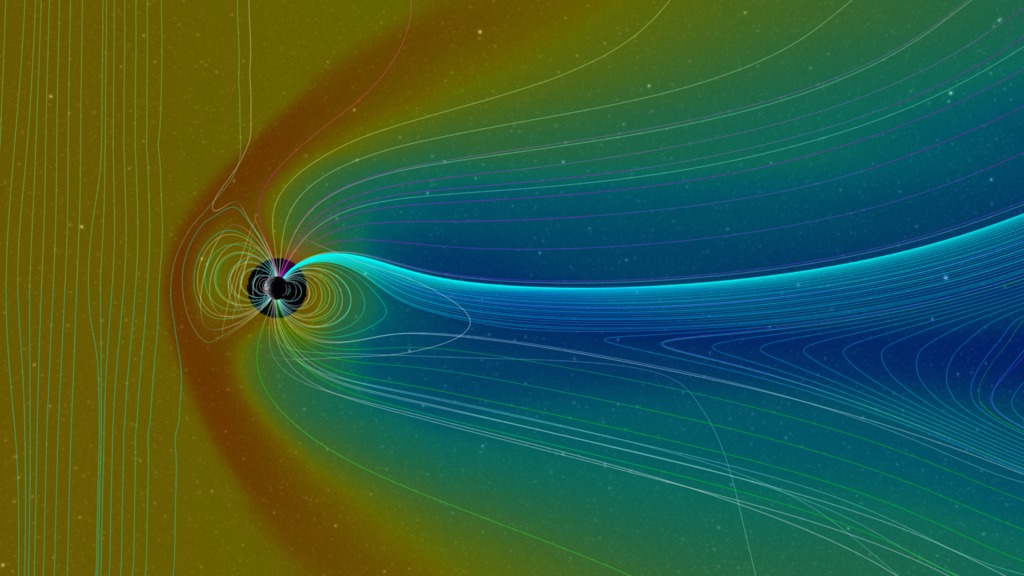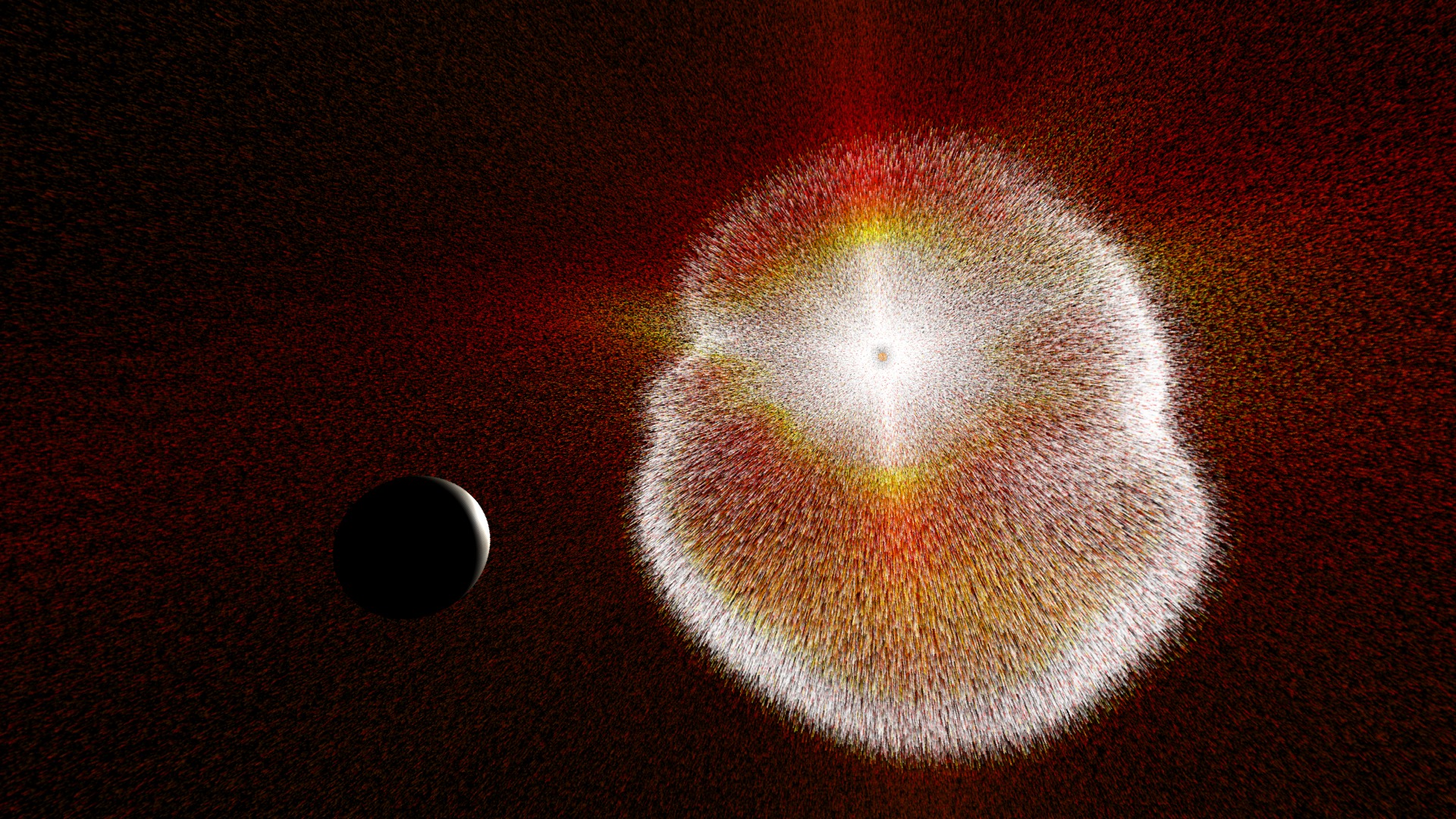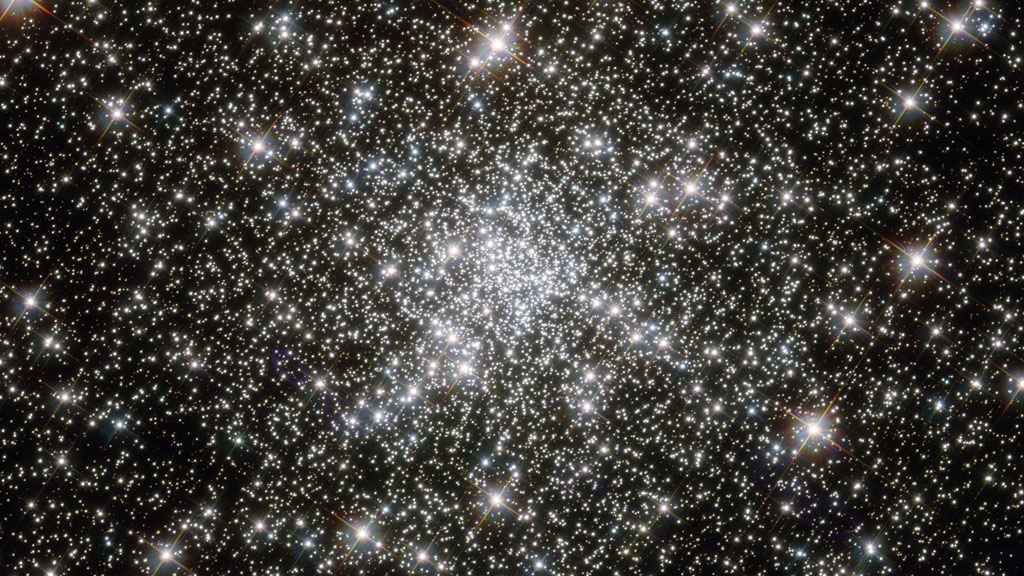A Coronal Mass Ejection strikes the Earth!
Energetic events on the Sun have impacts throughout the Solar System. This visualization, developed for the Dynamic Earth dome show, utilizes data from space weather models based on a real coronal mass ejection (CME) event from mid-December 2003.
Particles are used to represent the flow of solar material from the Sun around the Earth. It is important to note that the flowing material of the CME are actually ions and electrons far too small to see. This visualization tries to represent the motions of these tiny particles in a form large enough for us to see.
We open with a close-up view of the Earth, the particles representing the solar wind streaming around the Earth due to extended influence of the Earth's magnetic field. We pull out from the Earth and move so that we see the Sun in the distance. The enormous density enhancement in the solar wind is the coronal mass ejection. As the CME reaches the Earth, we see how effective the Earth's magnetic field is at diverting the solar material around the Earth. As the CME passes, we move earthward, and reveal the field lines representing the Earth's magnetic field, emanating from the magnetic poles and blown behind the Earth due to the influence of the solar wind. For simplicity, we have represented the Earth's magnetic field as unchanging, but it is actually very dynamic in its response to a CME or other change in the solar wind.
This movie shows the particle flow around the Earth as the CME strikes.
Credits
Please give credit for this item to:
NASA/Goddard Space Flight Center Scientific Visualization Studio
-
Animators
-
Greg Shirah
(NASA/GSFC)
- Horace Mitchell (NASA/GSFC)
- Tom Bridgman (Global Science and Technology, Inc.)
-
Greg Shirah
(NASA/GSFC)
Series
This page can be found in the following series:Datasets used
-
Magnetic Field Lines (Luhmann-Friesen) [Luhmann-Friesen Magnetosphere Model (1979)]
ID: 615Journal of Geophysical Research, vol. 84, Aug. 1, 1979, p. 4405-4408
This dataset can be found at: http://adsabs.harvard.edu/abs/1979JGR....84.4405L
See all pages that use this dataset -
Enlil Heliospheric Model (Enlil Heliospheric Model)
ID: 685MHD solar wind simulation
See all pages that use this dataset -
BATS-R-US Magnetosphere Model
ID: 686MHD Magnetospheric simulation
See all pages that use this dataset
Note: While we identify the data sets used on this page, we do not store any further details, nor the data sets themselves on our site.
Release date
This page was originally published on Tuesday, January 24, 2012.
This page was last updated on Wednesday, May 3, 2023 at 1:53 PM EDT.



![Produced VideoWatch this video on the NASA Goddard YouTube channel.Complete transcript available.Music Credit: "Praxis I,” “Three Voices,” and “Die Vogel” by Alexis Francois Georges Delong [SACEM], “Anticipation” by Nicholas Smith [PRS], “Ocean Wisdom” by Hugo Dubery and Philippe Galtier [SACEM], and “Call from the Sea” by MACARON [SACEM] from Universal Production MusicAdditional Video and Animations: University of Iowa, Southwest Research Institute, Millennium Space Systems, Andøya Space / Trond AbrahamsenSound Effects: Pixabay](/vis/a010000/a014800/a014862/14862_TRACERSoverview_Thumbnail.jpg)
![Watch this video on the NASA Goddard YouTube channel.Complete transcript available.Music credit: "Breakthrough Discovery" by Phillip John Gregory [PRS] from Universal Production Music](/vis/a010000/a014700/a014739/Thumbnail01.jpg)